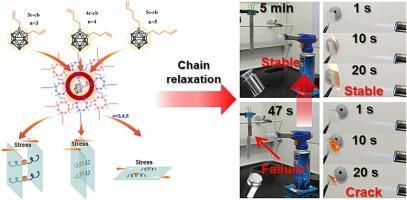高温下具有定制链长的碳化硼段的链松弛
IF 5.8
2区 化学
Q1 POLYMER SCIENCE
引用次数: 0
摘要
高性能热固性聚合物因其高度交联的网络而具有良好的热稳定性,但同时也存在拓扑约束,限制了分段的协同运动,因此即使在高温下也很难松弛应力。大多数热固性聚合物在高温下失效的原因是应力松弛效果不佳,这限制了热固性聚合物在恶劣环境中的应用。在此,我们采用了一种环硅氧烷杂化聚合物(CHP),其中含有碳链长度可调的邻碳硼烷段,以缓解内应力。邻碳硼烷的引入和碳链的延长都增加了 CHP 的自由体积分数,并降低了固化过程后期所需的活化能。碳链改变了构象,在高温下通过碳碳键的拉伸和旋转实现了链松弛,从而避免了开裂,提高了 CHP 的失效温度。此外,邻碳硼烷改性 CHP 的粘合强度最大达到 2.15 兆帕,超过了纯 CHP 的 1.23 兆帕。碳链最长的邻碳硼烷改性热电联产在承受烧蚀 5 分钟 1 千克载荷时表现出良好的稳定性,而纯热电联产仅在 47 秒后就失效了。邻碳硼烷改性热电联产通过链松弛抑制开裂,并在高温下原位生成氧化硼保护树脂基体,从而增强了高温性能。本文章由计算机程序翻译,如有差异,请以英文原文为准。

Chain relaxation of carborane segments with tailored chain length at high temperatures
High-performance thermoset polymers have good thermal stability due to their highly crosslinked network, while also represent topological constraints that restrict cooperative segmental motion, making it difficult to relax stresses even at high temperatures. Failure of most thermoset polymers at high temperatures is due to ineffective stress relaxation, which limits the use of thermoset polymers in harsh environments. Herein, we employed a cyclosiloxane hybrid polymer (CHP) containing o-carborane segments with tailored carbon chain length to relieve internal stress. The introduction of o-carborane and lengthening of carbon chain both increased the CHP fractional free volume, and reduced the activation energy required in the later stages of the curing process. The carbon chain changed the conformation to achieve chain relaxation by stretching and rotating the carbon–carbon bonds at high temperatures, which avoided cracking and increased the failure temperature of the CHP. Furthermore, the adhesion strength of the o-carborane modified CHP reached a maximum of 2.15 MPa, surpassing 1.23 MPa of the neat CHP. The o-carborane modified CHP with the longest carbon chain exhibited good stability while supporting 1 kg load for 5 min when subjected to ablation, whereas the neat CHP failed after only 47 s. The o-carborane-modified CHP exhibited enhanced high-temperature properties through chain relaxation to inhibit cracking and in situ generation of boron oxide at high temperatures to protect the resin matrix.
求助全文
通过发布文献求助,成功后即可免费获取论文全文。
去求助
来源期刊

European Polymer Journal
化学-高分子科学
CiteScore
9.90
自引率
10.00%
发文量
691
审稿时长
23 days
期刊介绍:
European Polymer Journal is dedicated to publishing work on fundamental and applied polymer chemistry and macromolecular materials. The journal covers all aspects of polymer synthesis, including polymerization mechanisms and chemical functional transformations, with a focus on novel polymers and the relationships between molecular structure and polymer properties. In addition, we welcome submissions on bio-based or renewable polymers, stimuli-responsive systems and polymer bio-hybrids. European Polymer Journal also publishes research on the biomedical application of polymers, including drug delivery and regenerative medicine. The main scope is covered but not limited to the following core research areas:
Polymer synthesis and functionalization
• Novel synthetic routes for polymerization, functional modification, controlled/living polymerization and precision polymers.
Stimuli-responsive polymers
• Including shape memory and self-healing polymers.
Supramolecular polymers and self-assembly
• Molecular recognition and higher order polymer structures.
Renewable and sustainable polymers
• Bio-based, biodegradable and anti-microbial polymers and polymeric bio-nanocomposites.
Polymers at interfaces and surfaces
• Chemistry and engineering of surfaces with biological relevance, including patterning, antifouling polymers and polymers for membrane applications.
Biomedical applications and nanomedicine
• Polymers for regenerative medicine, drug delivery molecular release and gene therapy
The scope of European Polymer Journal no longer includes Polymer Physics.
 求助内容:
求助内容: 应助结果提醒方式:
应助结果提醒方式:


